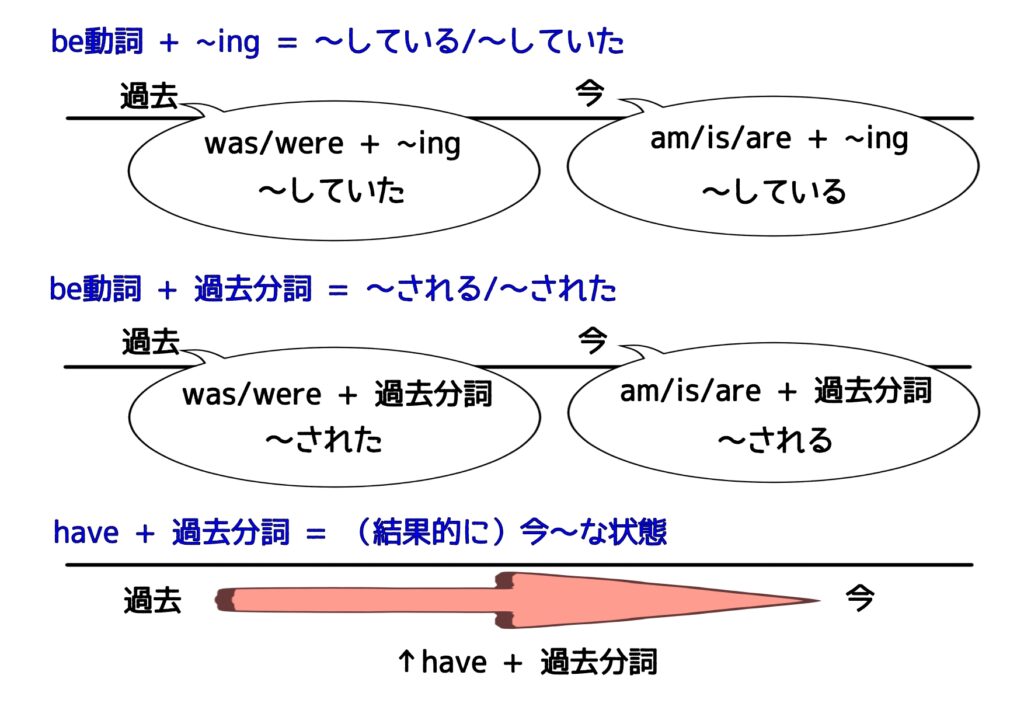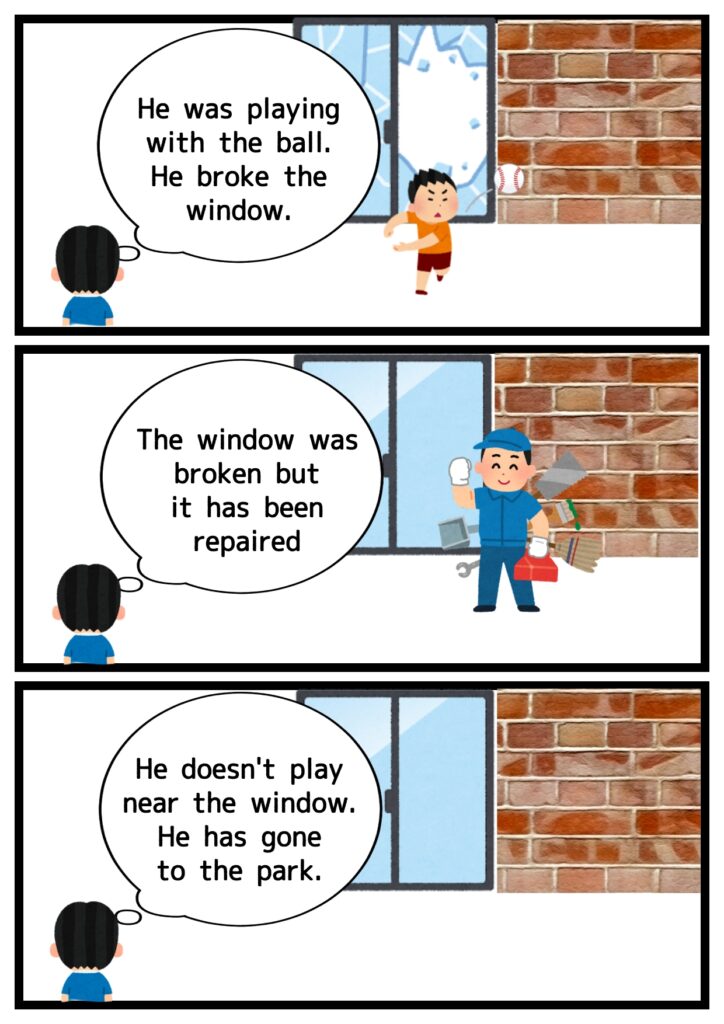第23回:文法に応じた一般動詞の形と、それぞれの意味の復習です。

忘れた始めた頃に復習することが大事。とは分かっていても、
あの時何したっけ?ってなって、また1からやり直す無限ループ。
効率良く勉強することって、なかなか大変ですよね。
Q. この記事で、一番大事なことって何?
A. 大事なことを、1枚の画像にまとめました。

いちいちノートにまとめるのが面倒だという方、また、
ノートにまとめることが苦手だという方は、ご活用ください。

Q. part 1 からpart 22までの間に何があったっけ?
A. 今回の記事は、これまでの重要文法の復習になります。
覚えきれていないようでしたら、以前の記事も参考にしてみてください。
be動詞 + -ing(動詞のing形) = 進行形(〜している/〜していた)



be動詞 + 過去分詞 = 受け身(受動態)(〜される/〜された)


have + 過去分詞 = 現在完了形(今までに〜したことがあるetc.)




do/does/did + 動詞の原形



[広告]
確かな英語力は、日々の継続から。
その継続を後押しする、第二言語習得理論に基づいた
オンライン英語学習プログラムがあります。
英語を使う人のための、確実なスキルアップが望める
7日間の無料体験はこちらから!

Q. これらの表現を使うと、どんな文ができるの?
A. 例文を何個か書いておきます。

I am studying.
私は勉強しています。

Butter is made from milk.
バターは牛乳から作られます。

He hasn’t been to France.
彼はフランスに行ったことがありません。

I don’t go out very often.
私はあまり外出しません。
[広告]
子どもに英語を学ばせたい!
けど、子どもは、なかなかやる気にならない…
ならば、親子で一緒に英語を勉強してみれば良いじゃない!
英語を学ぶ全ての人に、親身になってサポートしてくれる講師が
教えてくれる、オンライン英会話スクールは、こちらから。

Q. これらの表現は、どんな時に使えるの?
A. この表現が使える場面をイラストにしてみました。

[広告]
もっと簡単に中学内容の英語を学び直しましょう!
リスニングを始め、豊富なコンテンツで飽きずに続けられる。
基礎固めをするだけで、英語が話せるようになります!
多くの人に指示された教材を使って開発され、サポートも充実!
今度こそ、話すための英語を身につけましょう!
最新のテクノロジーを活用した英語学習サービス、
Simon Method の公式ホームページはこちらから。

補足:イラストの日本語訳

He was playing with the ball. He broke the window.
彼はボールで遊んでいた。彼は、窓を壊した。

The window was broken but it has been repaired.
窓は壊されたけれど、修理されて新品になった。

He doesn’t play near the window. He has gone to the park.
今、彼は窓の近くで遊んでいません。彼は公園に行きました。
[広告]
ロゼッタストーン・ラーニングセンターで、最先端の教育制度を活用して英語を学びませんか?私たちは個々の学習ペースに合わせてeラーニングと対面教育を組み合わせ、柔軟な学習環境を提供しています。自宅でのeラーニングと対面教育のメリットを最大限に活かし、あなたの英語学習をサポートします。最新のテクノロジーと個別の指導が組み合わさった当センターで、自由な学習スタイルを体験してみませんか?英語学習を楽しく効果的に進めるための環境がここにあります。新たな一歩を踏み出して、新しい英語学習の旅に参加しましょう!

Q. この記事の要点は?
A. 進行形・受け身・完了形・doの使い方の復習でした。
自分が勉強しているレベルに合わせて、
文法事項を覚えているか確認してみましょう。
文法は、スポーツで言うところのルールブックみたいなもの。
英語学習のゴールは、英語を使えるようにすること!
英語を使うとは、スポーツで言うと、試合に出るようなもの。
試合にでる、つまり、会話で活用できるようにするためには、
練習をしないといけません。
文法を自由自在に活用するために、
第二言語習得理論という学問の観点から作られた、
一人でもスピーキングの基礎練習ができる参考書があります。
参考書も、自分に合った物を選ぶことが大切ですが、
英会話に割く時間がない方は、
この参考書で、一人でも英会話の練習が出来るはずです!
次回の文法解説は?
不規則動詞の変化をまとめます。
---
この記事を作る際に参考にした文法の解説書になります。
すべて英語で書かれていますが、練習問題が付いてます。
イギリス英語なので、スペル等の表記が異なる部分もありますが、
「使い方を練習したい」「繰り返し問題を解きたい」
という方は、使ってみても良いかもしれません。
他の文法解説記事を検索できます。





-320x180.jpg)




コメント